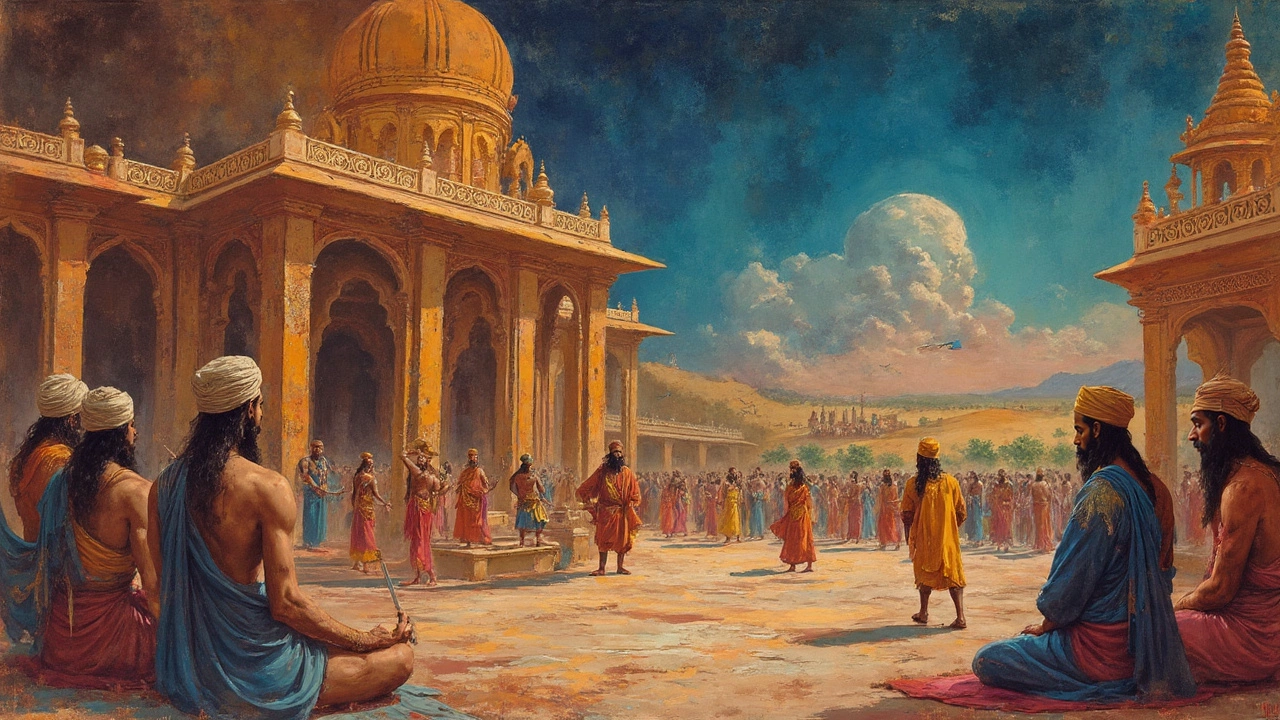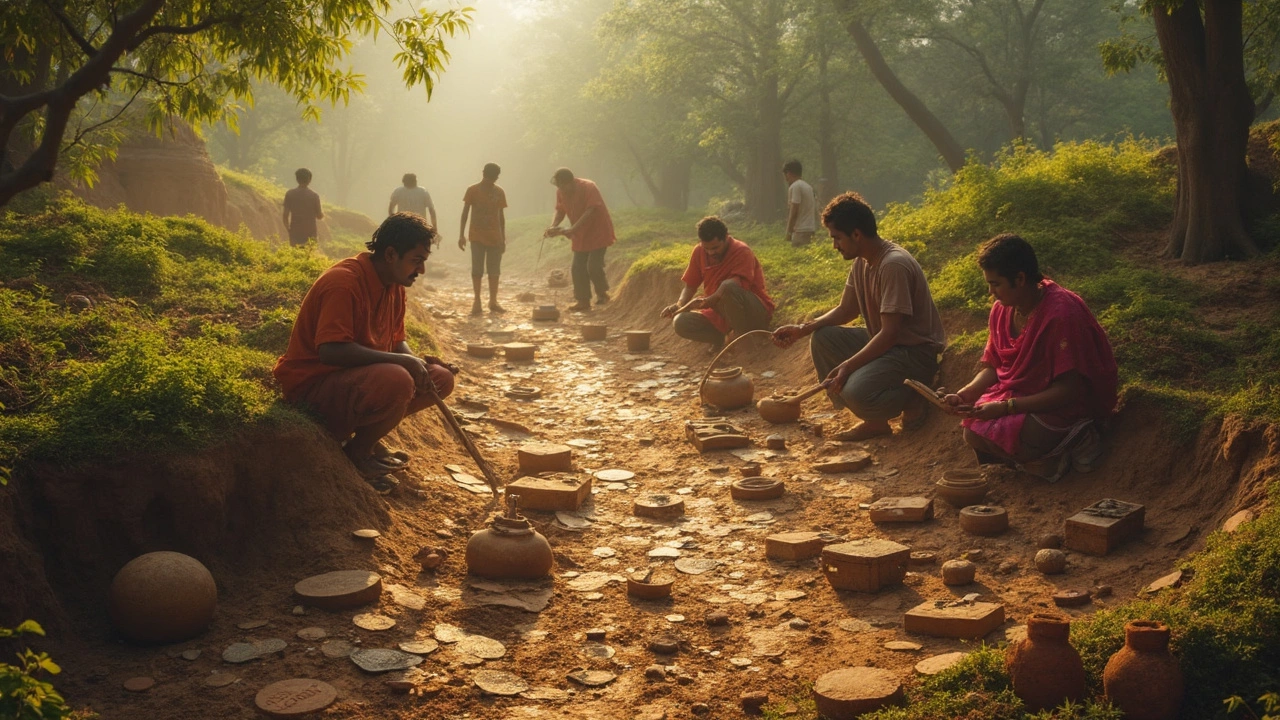Is the Mahabharat Real or a Myth?

Ever found yourself caught up in the tales of the Mahabharat, wondering if those epic battles and divine interventions really happened? You're not alone. The Mahabharat has been a vital part of Indian culture for centuries, stirring imaginations and raising eyebrows. Let's take a peek into the world where gods walked among men and ask: Is it history, or is it myth?
First off, many folks point to certain places in India that are linked to events in the Mahabharat. Kurukshetra, for instance, is known as the battlefield of the epic war. Archaeologists have occasionally found artifacts that resemble descriptions in the texts. But does this prove the whole saga real? Eh, not quite.
What about the cultural impact? The Mahabharat isn't just a story; it's a part of how many in India understand the world. Characters from it are held as moral examples or warnings. The lessons from the epic shape personal and spiritual lives, threading into the fabric of day-to-day decisions.
Historical Evidence
Diving into the historical side of the Mahabharat is like going on a treasure hunt. There's loads of debate among historians and archaeologists about whether there's solid proof linking this epic to actual events.
Archaeological Discoveries
In places like Kurukshetra and Hastinapur, digs have turned up stuff that's got everyone buzzing. Pots, ruins, and artifacts date back to the supposed timeframe of the Mahabharat. But here's the kicker: while these finds raise eyebrows, they don't exactly connect all the dots to the epic as a factual story.
Chronicles and Dates
The timeline of the Mahabharat is another head-scratcher. There's some neat astronomical data within the texts, like eclipses and planetary positions. Researchers have used these clues to pinpoint possible dates, ranging from 3,000 BCE to 1,500 BCE. But remember, this is like playing detective without a clear roadmap.
Written Records
While the Mahabharat is filled with drama and intrigue, there are no contemporary records outside the epic itself to back up its claims. Despite this, its first written form is believed to have existed over 2,000 years ago, well after the supposed events. This gap in time has led to a mix of myth and potential history.
Other Epics and Comparative Mythology
Comparing the Mahabharat with other ancient texts provides some interesting parallels. Similar mythological tales exist in different cultures, which shows how humans everywhere like to weave these grand stories. It doesn't quite confirm any factual basis, though. More like it puts the spotlight on how meaningful this epic has been worldwide.
So, does the Mahabharat recount an ancient reality, or is it a deeply rooted myth that offers cultural and moral value? The answer is a bit of both, hanging in that fascinating space between truth and storytelling.
Cultural Impact
The Mahabharat is more than just a story to many in India. It's a guidebook for life, full of moral dilemmas and solutions that have woven themselves into the cultural consciousness.
Stories and Traditions
Generations have passed down stories from the Mahabharat, keeping its lessons alive. Characters like Krishna, Arjuna, and Draupadi aren't just figures in a book; they represent ideals and virtues people try to emulate. From childhood tales to grand theatre productions, these stories find their way into daily life.
Festivals and Rituals
Many festivals have roots tied to the Mahabharat. Take Janmashtami, celebrating Lord Krishna's birth; it reminds us of his role in the great epic. The teachings of the Mahabharat often find their way into religious discourses during these celebrations, influencing beliefs and practices.
Artistic Inspirations
The epic has inspired various art forms, from classical dance to modern cinema. Kathakali and Bharatanatyam often depict scenes from the Mahabharat, bringing its characters to life through dance and music. Bollywood has also taken a keen interest, reinterpreting these age-old tales for modern audiences.
Philosophical Teachings
The Mahabharat isn't just about battles and kings. It's where you find the Bhagavad Gita, a conversation between Krishna and Arjuna that dives deeply into life's philosophies. These teachings on duty, righteousness, and devotion continue to influence thinking today.
So, while we debate whether it's real or myth, the Mahabharat undoubtedly shapes cultural norms and values, making its presence felt across different facets of life.

Modern Interpretations
In today's world, how we see the Mahabharat has changed a lot. Thanks to movies, TV shows, and the internet, more people are interested in this epic than ever before. But here's the catch: not everyone agrees on what it means or how it should be told.
Re-Telling the Classic
Filmmakers and writers have taken creative liberties, giving the characters new life and sometimes entirely different stories. Directors often film in vibrant colors, with grand costumes and sets that might not be accurate but sure are eye-catching. These adaptations keep the Mahabharat alive for modern audiences who might never pick up a 2000-page book but will binge-watch a 10-hour series.
Debate Over History vs. Myth
With all this new content, debates rage on about what's real and what's made up. Some view the Mahabharat as actual history, pointing to archaeological evidence and ancient texts. Others argue it's more like an intricate myth, full of moral lessons rather than factual accounts. Still, the search for truth continues.
Impact of Technology
Technology's role here is crucial. Online forums and social media platforms have become hot spots for fans and scholars alike to dissect episodes and chapters. These platforms allow for a more interactive experience, where everyone from historians to casual fans can weigh in.
Statistics and Facts
Believe it or not, a survey conducted in 2023 found that 60% of Indian teenagers learned about the Mahabharat through digital media first. This choice highlights how tech is changing traditional education.
| Source | Knowledge |
|---|---|
| Digital Media | 60% |
| School Textbooks | 25% |
| Family Stories | 15% |
All told, whether you see it as a myth, history, or a blend of both, one thing is clear: the Mahabharat remains relevant today, continuously interpreted through the lenses of modern culture and technology.
Conclusion
So, after all this digging, what's the verdict? Is the Mahabharat history, or is it just an elaborate myth? Honestly, it's a bit of a mix. On one hand, there are elements that feel larger than life, like gods lending a hand in battles or weapons with supernatural powers. On the other hand, some details line up with historical artifacts and the geography in India, which suggests it wasn't all make-believe.
Interestingly, the Mahabharat wasn't written in one go. It evolved over centuries, with different authors throughout time adding their own spin. This makes pinning down its historical accuracy tricky, as the line between fact and folklore got blurrier with each retelling.
Even today, the Mahabharat isn't just about what may have happened long ago. It's a living, breathing part of Indian culture. It continues to inspire books, TV shows, and movies, not just in India, but globally. This speaks volumes about its lasting impact.
Here's the thing: whether you see it as fact or fiction, the Mahabharat still teaches lessons about life, ethics, and duty. It's a myth that's just as much about the stories it tells as the truths it reveals about human nature.
So, maybe asking if the Mahabharat is real or a myth isn't the right question. Instead, perhaps we should ask: how does its story inspire us today?